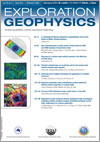
Exploration Geophysics
Volume 45 Number 2 2014
EG13012A combinatorial filtering method for magnetotelluric time-series based on Hilbert–Huang transform
Magnetotelluric (MT) time-series are often contaminated with noise from natural or man-made processes. A combinatorial method is described for filtering of MT time-series based on the Hilbert–Huang transform that requires a minimum of human intervention and leaves good data sections unchanged.
EG12026Site characterisation in north-western Turkey based on SPAC and HVSR analysis of microtremor noise
Microtremor (passive seismic) array data were used to study sediment thickness in two pull-apart basins located at Düzce and Bolu on the North Anatolian Fault (Turkey). SPAC processing of array data allows estimation of shear-wave velocity in upper layers about 5 m thick (Vs < 200 m/s), and to depths of about 100 m. Inclusion of HVSR data extends the useful frequency range by an order of magnitude and allows resolution of two interfaces of moderate Vs contrast in soft Miocene and Eocene sediments.
EG13030Discovery of a surface wave velocity anomaly in the West Sea of South Korea
Our study shows that a fracture zone concerning the Permo-Triassic collision exists below the north-eastern sea of the HUK station in South Korea. Recent studies regarding ambient noise tomography in hydro-carbon fields show that the anomaly might have resulted from the hydro-carbon reservoir. In the near future, the ambient noise tomography (ANT) method can replace seismic survey dominantly using body waves to find oil and gas reservoirs.
EG13066Perfectly matched layer on curvilinear grid for the second-order seismic acoustic wave equation
Theoretical expressions and analysis of curvilinear-grid PML are presented. PML model 1 with symmetric form and PML model 2 with asymmetric form are derived from the same acoustic wave equation. The examples given show that the symmetric-form PML yields better modelling results than the asymmetric-form PML.
EG13052Converted-wave imaging technology and application for complex structures
Most existing multi-component surveys are deployed in areas with geologically simple structures due to processing challenges. This paper presents a case study of a 3D3C seismic survey with complex structures and faults. We hope that this workflow will provide a technical guide or reference for multi-component exploration with complex structures.
EG13098Numerical simulation using a Hamiltonian particle method for effective elastic properties in cracked media
We apply a Hamiltonian particle method (HPM) to simulate seismic wave propagation in a cracked medium. The calculated effective elastic moduli of the cracked medium using the HPM showed good agreement with the modified self-consistent theory.
EG13084The use of GPR attributes to map a weak zone in a river dike
In degraded dikes, the crack permeability is increased and damp patches can build up. GPR signal attributes and spectra of GPR traces allow us to locate the more permeable sections of the dike. This has been proven in the interpretation of GPR measurements after the May 2010 flood in Cracow.
EG12053Application of high resolution airborne geophysical data in geological modelling of Mohar Cauldron Complex, Bundelkhand Massif, central India: implications for uranium exploration
High resolution airborne geophysical data were acquired by Fugro Airborne’s GEOTEM system over the Mohar Cauldron Complex (MCC). Advanced processing and interpretation mapped the major geological domains and indicated the presence of three felsic intrusive bodies. The boundary of the sediments within the MCC and subsurface distribution of conductivities are accurately mapped.

